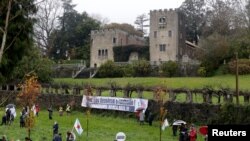A palace where Spain’s longtime ruler, the late General Francisco Franco, spent his summers was like an Aladdin's Cave full of treasures.
Pazo de Meiras, a 16-acre property in Galicia, northwestern Spain, housed two 12th century sculptures of the prophets Isaac and Abraham, paintings by Spanish masters such as Zuloaga, royal tapestries and valuable glassware among hundreds of items which the general's heirs enjoyed after he died in 1975.
All this came to an abrupt end on Thursday after the Franco family were ordered by a court to hand over the keys to the property to the Spanish state.
It was the end – for now – of a long legal battle between Spain's left-wing government who have fought to reclaim the historic mansion for the national heritage and the late leader's descendants who claim it is their property.
Pazo de Meiras symbolizes a victory for Spain's Socialist government which since coming to power in 2018, has made it a priority to rid the country of the vestiges of Franco’s decades-long rule – a time that many on the left remember as a period of repression.
A court ordered the late leader’s descendants to vacate the property but before they left Judge Marta Canales asked for an inventory of all valuable items to be made to insure none were pilfered.
Some 637 items listed in the 1,000-page document revealed the opulent life enjoyed by General Franco and his family.
The most important works are the sculptures of Isaac and Abraham which formed part of the Portico of Gloria in the Cathedral of Santiago de Compostela, until they became the property of the Francos in the 1950s.
Other items found in the chapel included a bull from Pope Clement VIII dating from the 16th century and royal tapestries.
The library includes 13,000 books, some owned by Franco and his family, others which were the property of Emilia Pardo Bazan, a writer, who was the original owner of the mansion.
Some personal items have come to light including the playhouse of Franco's daughter Carmen Polo, with its own granary and well, all built to scale.
Symbolic handover
As she prepared to receive the keys to the property, Carmen Calvo, Spain's deputy prime minister, said: “I wanted to dedicate this to the thousands and thousands of men and women from Galicia and the rest of Spain who have tried to make this a place for the heritage of all.”
One of these is Carlos Babio, who has campaigned for years to reclaim the Pazo de Meiras for the Spanish people.
“Today is a historic day after years of fighting for this moment,” he told VOA.
“However, this has been a strange battle as we have had to fight for 40 years in a democracy to get rid of the family of a dead dictator. Yet the property should have been ours from the start.”
Last month, a court in the city of A Coruña in Galicia ordered the Franco family to turn it over to state ownership, upholding a Spanish government complaint filed last year claiming the 1941 sale to Franco was “fraudulent.”
Franco's family has claimed the property, which was built between 1893 and 1907, was their own property.
The estate was acquired by a Francoist organization at the end of the 1936-1939 civil war and they later signed it over to the victorious leader.
The court challenged the 1938 donation and subsequent sale in 1941, ruling it “null” and “void”, since it was transferred to “the head of the state and not to Francisco Franco personally”.
It also found that the sale was little more than a “pretense” because Franco did not pay anything for the property.
The court ordered the Franco family to “immediately hand over the property without being compensated for the expenses they claim to have incurred for its maintenance”.
“On accepting that the country estate belongs to the state, the judge also declared null and void the transfer of the property to Franco's heirs”, after the General's death in 1975, a court statement said.
In 2018, Galicia's regional government declared the country property to be of “historic and cultural value”, ordering the Franco family to open it up to the public.
Benito Portela, Sada's mayor, believes the building should be turned into a center for the recovery of historical memory about the Franco era.
Fight not over
However, Francis Franco, one of the late general's six grandchildren, insisted the family would appeal against the court ruling.
“This has all been a circus. We can get no justice from this Socialist communist government. Whatever we do they get the courts to rule against us. It is rigged,” he told VOA.
Police were stationed outside the mansion last month amid reports that the Franco family were planning to strip the property of its contents and had hired 50 trucks to clear the mansion.
The family had previously tried to sell the mansion, putting it on the market with a price tag of $9.68 million.











